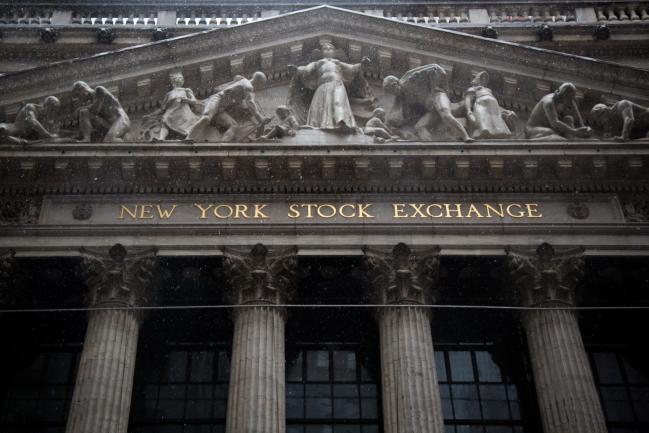(Bloomberg) -- As the U.S. equity bull market heads into its 10th year with earnings underpinning the case for buying, consider this: at the most important turning points for stocks in the past decade, profit projections have been laughably wrong.
Take the start of this bull market, nine years ago today. Banks were failing, the economy was shrinking, and stocks had just suffered their worst year in seven decades. Equity forecasters were appropriately grim, predicting a double-digit decline in corporate income that would’ve ranked among the worst ever seen. Instead, earnings rose.
Step back a bit further to October 2007, when shares had gained for five straight years. Analysts were projecting a solid increase in S&P 500 Index profits for the fateful year of 2008. They were off by 41 percentage points.
Of course, estimates aren’t always that wrong. But assuming they’re reliable isn’t a safe bet, either. It’s a point worth heeding now because Donald Trump’s tax cuts and an uptick in global growth have analysts boosting earnings estimates at the fastest pace on record. And that profit backdrop has been repeatedly cited by strategists from JPMorgan Chase & Co (NYSE:JPM).’s Dubravko Lakos-Bujas to Jonathan Golub at Credit Suisse (SIX:CSGN) Group AG as reason to buy the dip.
“People continue to draw a straight line on the path that we’re on, and we know the world works in cycles and is not necessarily linear,” said Jerry Braakman, chief investment officer of First American Trust in Santa Ana, California, where he helps oversee about $1.3 billion. “Analyst expectations are fine if the trend continues, but when you have a significant change, growth is overvalued.”
Volatility Returns
Last month’s correction, the biggest in two years, occurred side by side with the unprecedented stretch of analyst upgrades. Volatility is returning after a torpid 2017 as Trump, whose $1.5 trillion tax overhaul was greeted with record equity inflows in January, turns toward a protectionist stance on trade. The Federal Reserve, cheerleader of gains that have added $22 trillion to American equity values since 2009, is becoming a less reliable ally too.
Those shifts are forcing investors to reassess the durability of the bull market, according to Joseph Tanious, a senior investment strategist at Bessemer Trust in Los Angeles, which oversees more than $100 billion.
“Whether it’s fears of a trade war, whether it’s inflation starting to pick up, all these things add to anxiety, which ultimately leads to greater levels of volatility,” said Tanious. “We had a pretty amazing ride over the last nine years. Statistically it’s a very long cycle. Understandably investors get nervous.”
The S&P 500 climbed 0.9 percent to 2,764.47 as of 10:35 a.m. Friday, after labor department data showed inflation fears stirred by last month’s jobs report may have been overdone. While the U.S. added more workers than expected in February, average hourly earnings increased 2.6 percent from a year earlier, missing expectations for a 2.8 percent gain.
Read more about Trump and the Fed’s recent impact on stocks.
The bull market is just five months away from becoming the longest ever and at 21 percent, the consensus forecast for 2018 profit growth would top all other years during the rally except for one. But Wall Street’s record of predictive success doesn’t exactly instill confidence. From 2007 through 2017, the actual pace of S&P 500 earnings-per-share growth was on average 6 percentage points lower than what analysts had expected at the end of the previous year, according to data compiled by Bloomberg.
Moreover, history shows that earnings matter less to stock prices when multiples are already high and inflation is rising. Ie, in situations like now.
Jim Paulsen, chief investment strategist at Leuthold Group, has found eight instances since 1950 where profits surged and stock prices didn’t. A common theme among them: stretched valuations and a low unemployment rate. One explanation is that earnings lose the power to drive up share prices when stocks are expensive and the risk of an overheating economy -- as evidenced by a tight labor market -- is rising.
Both concerns are relevant today, with the S&P 500’s price-earnings ratio hovering around the highest level since the dot-com era and the country’s jobless rate holding at just 4.1 percent.
“Eras of robust earnings growth do not always ensure a good stock market,” Paulsen wrote in a note in late February. “With most over the moon about what appears to be a tremendous earnings year, perhaps it may make sense to curb your enthusiasm about the stock market?”
Another hidden risk lies in the slope of the S&P 500 earnings trajectory. While finding fault with bumper growth may seem like looking a gift horse in the mouth, the phenomenon is not necessarily good news.
Ned Davis Research grouped S&P 500 earnings growth since 1927 into five brackets and found that unless it’s too bad to ignore (down an annual 25 percent or more), income growth tends to have an inverse relationship with market returns. That is, the faster profits grow, the worse stocks perform.
| Earnings Growth Rate | S&P 500 Gain/Annum | % of Time |
| Above 20% | 2.6 | 23.2 |
| Between 10% and 20% | 7.6 | 22.3 |
| Between -10% and 10% | 9.2 | 36.6 |
| Between -25% and -10% | 25.0 | 10.5 |
| -25% or worse | -23.7 | 7.4 |
| Source: Ned Davis |
While it sounds counter intuitive, it makes sense in that markets always look ahead. Once the good news on profits is priced in, that doesn’t leave much room for stocks to keep going.
“It seems too good -- you can’t model long-term 20 percent growth,” Lamar Villere, portfolio manager of the Villere Balanced Fund who manages $2.1 billion, said in an interview at Bloomberg’s New York headquarters. “People freak out and can’t believe that can go on indefinitely.”
